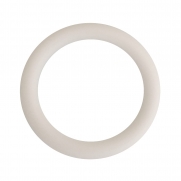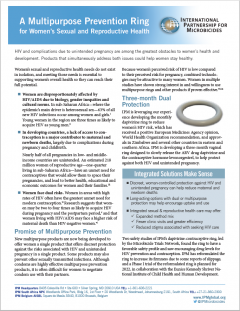Dapivirine-Contraceptive Ring
Fast facts
- Acts against: HIV-1; unintended pregnancy
- Delivery method: Vaginal ring
- Active ingredient: Dapivirine (ARV); Levonorgestrel (contraceptive hormone)
- Length of action: Three months
- Status: Two Phase I trials completed; next Phase I trial planned
Why is the dapivirine-contraceptive ring important?
The multipurpose prevention ring would offer women a discreet, self-initiated and long-acting product to simultaneously meet two major sexual and reproductive health needs, as well as offer greater convenience.
How does the dapivirine-contraceptive ring work?
The ring is made of a flexible polymer and contains dapivirine, an ARV, and levonorgestrel, a contraceptive hormone, both of which are slowly released over the course of three months. Women insert the ring into the vagina themselves and replace it every three months.
What is its development history?
Building on the ring technology used to develop the monthly dapivirine ring, IPM began developing the dapivirine-contraceptive ring in 2011 under a grant from the U.S. Agency for International Development through the President’s Emergency Plan for AIDS Relief. Early prototypes of a two-month dual-purpose ring were developed in collaboration with Particle Sciences and Queen's University Belfast. In 2014, after evaluating multiple materials and formulations, IPM and Queen's University Belfast targeted a three-month dual-purpose ring.
What is its clinical history?
Two Phase I trials to assess the safety and pharmacokinetics of the dapivirine-contraceptive ring have been completed:
- In October 18, results from MTN-030/IPM 041 found the dual-purpose ring to be well-tolerated, and encouraging drug levels were seen in blood and vaginal fluid, when used for 14 days in 24 healthy, HIV-negative, non-pregnant women in the United States.
- In March 2021, results from MTN-044/IPM 053/CCTN 019 found the ring was well-tolerated and delivered sustained levels of both drugs when used for 90 days in 24 healthy, HIV-negative, non-pregnant women in the United States.
Both trials were conducted by IPM’s clinical trial partner, the US National Institutes of Health-funded Microbicide Trials Network.
What are the next steps for the dapivirine-contraceptive ring?
Two Phase I trials showed encouraging results that support further development of the ring. Due to some participant reports of slippage and expulsions in the second Phase I trial of the product, IPM has since reformulated the ring to increase its firmness. A Phase I trial of the reformulated ring, in collaboration with the Eunice Kennedy Shriver National Institute of Child Health and Human Development (NICHD) is planned to initiate in 2022.
Who is IPM currently partnering with to develop and test the ring?
- ARV license: Janssen Sciences Ireland Unlimited Company for dapivirine
- Development: Queen's University Belfast
- Manufacturing: Sever Pharma Solutions (formerly QPharma)
- Clinical trial: Microbicide Trials Network; NICHD
Where can I learn more about multipurpose rings?
- Our lead ARVs: Dapivirine
- Fact sheet: A Multipurpose Prevention Ring for Women's Sexual and Reproductive Health
- Results from MTN-044/IPM 053/CCTN 019: R4P 2021 abstract
- Results from MTN-030/IPM 041: MTN press release
- Publication: New Technologies for Women’s HIV Prevention: The Payoff for Sustainable Development
- Scientific publications
- Resource: CAMI Health

